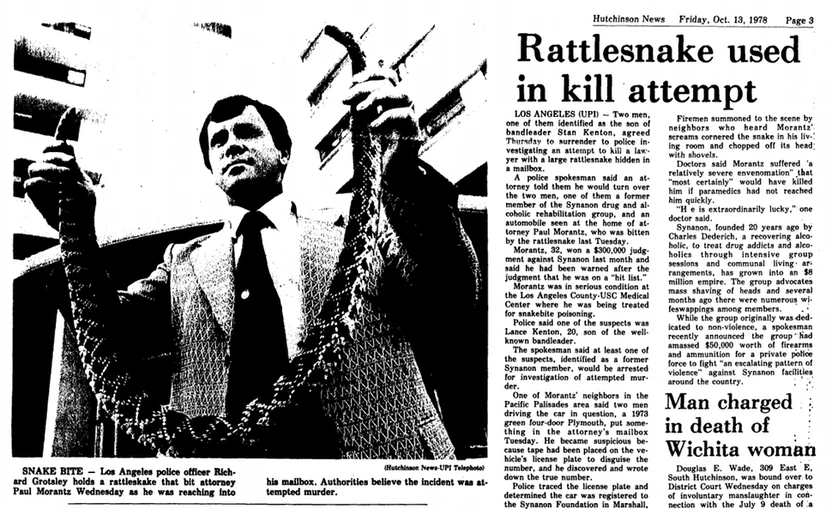LA: Rehab & Rattlesnakes – Counter-Cultural musings from TSPTR. Dossier #5
In the fifth of our monthly counter-cultural musings from TSPTR, we look at straightening up in LA
Before Synanon there was no drug rehab. Launched in a dingy Santa Monica storefront in 1958 by Charles Dederich, it opened centres up and down California, eventually morphing into a utopian community, then a religion and finally a cult worth more than $30 million. Members shaved their heads, wore overalls, and lived together at Synanon compounds, professing a steadfast obedience to Dederich, no matter how brutal his methods.
A college dropout and a drunk, Charles Dederich bounced from job to job, marrying, divorcing, and marrying again. In ’57 he took part in an experiment at UCLA testing LSD as a cure for alcoholism. Speaking to an oral historian documenting Synanon’s short history in ’62, Dederich called it “the most important single experience in my entire life”, crediting the drug with unlocking a newfound confidence. “I became a different person, really and truly,” he said. “Everything that has happened to me since – Synanon, everything – dates from that point.”
Born in 1913 in Toledo, Ohio, Dederich was four when his alcoholic father died in a car accident. His mother raised him as a devout Roman Catholic. “I believed, literally, that I would go to hell if I didn’t go to church on Sundays,” Dederich recalled. But when he was 14, he read his stepfather’s copy of H.G. Wells’s The Outline Of History and “became a militant atheist, almost overnight”. Soon after, he began drinking.
Easily bored, Dederich wasn’t one for learning or for working. He spoke in a growl and was overweight, the right side of his bulldog face drooping from a near-fatal bout of meningitis at 29. Dederich came out west to Santa Monica at 40, his second marriage in mid-collapse. He floundered for three years in the ocean breeze before walking into his first meeting of Alcoholics Anonymous. Partway through, Dederich marched to the podium and shared with the group. People listened. They laughed, they applauded. Dederich was hooked. “I went from one AA meeting to another every night,” he told psychiatrist Daniel Casriel, one of a number of social scientists to write books on Synanon in the ’60s. “That’s all I did… I was the first one to speak, and I’d speak all night unless they stopped me.”
After the acid experiment in ’57 (he was one year sober at the time), Dederich became a voracious reader of philosophy and psychology. Looming especially large were the nonconformity espoused by Emerson in “Self-Reliance” and the utopian notions put forth by Thoreau and Skinner. He was living on $33-a-week unemployment checks, and he began to taper off from AA. When other recovering alcoholics checked up on him, Dederich would engage them in impromptu meetings. Equal parts grad-school symposiums and combative group-therapy sessions, those get-togethers became thrice-weekly affairs.
Then one day a young heroin addict named Whitey Walker, fresh out of prison, joined the group. As he began inviting other “dope fiends” to the mix, the language grew coarser, the cross talk more aggressive. Dederich loved it. The sessions became known as “synanons”, a portmanteau of “symposium” (or perhaps “seminar”) and “anonymous.” Dederich, who provided couches for people to crash on as they kicked heroin, would come to believe that addicts weren’t full-fledged adults and shouldn’t be treated as adults. The younger addicts took to calling him Dad.
When the gatherings grew too large for Dederich’s apartment, he leased a storefront in Ocean Park for $100 a month. The same year, 1958, the group incorporated as a non-profit. Convinced that his creation was an innovation on par with the alphabet, Dederich predicted it would be as famous as Coca-Cola. Thus, began the media’s decade-long enchantment with Synanon. Early on, the Los Angeles Times ran a two-part feature on the group. The Los Angeles Mirror published a four-part series. A 14-page photo spread in Life magazine, hailing Synanon as “a tunnel back into the human race”, was followed by a glowing write-up in Time magazine.
US Senator Thomas J. Dodd declared that Synanon could “lead the way in the future to an effective treatment for not only drug addicts but also criminals and juvenile delinquents”. Social scientists flocked to see for themselves, while Hollywood came out with the film Synanon in ’65, starring Edmond O’Brien as Charles and Eartha Kitt as Betty.
Ten years after its founding, Synanon boasted at least 1,100 members and was receiving $2.5 million a year in donations. It had $7 million worth of real estate in Santa Monica, West LA, San Diego, San Francisco, Tomales Bay, Reno, Detroit, New York City, and Puerto Rico, owned a number of gas stations, and ran a $1 million-a-year specialty advertising business that sold pens and office supplies bearing the Synanon logo. Salesmen implored Fortune 500 companies to “buy from Synanon and save a life”.
Few noticed, but the Synanon mission had been shifting. In ’69 the organisation dropped the goal of “graduation.” From then on, addiction could be treated only by keeping addicts within the fold. Synanon began to welcome nonaddicts like Ritter, too, and Dederich suggested that he was “getting out of the dope-fiend business”. He created the “punk squad”, a sort of boot camp devoted to disciplining “juvenile delinquents” sent to Synanon by their parents and the courts. And the organisation began marketing the group truth telling sessions known as ‘The Game’ as a new kind of therapy.
“Synanon rebranded itself in the ’70s from a drug treatment program to a psychotherapy program and started attracting middle-class people through the Synanon Game,” says sociologist Richard Ofshe, who spent time in the organisation studying it as a non-resident. By the early ’70s, some 3,400 squares in California, New York, and Detroit were paying cash to participate in Games. It was the heyday of the human-potential movement, when Americans were rushing off to therapists’ couches, new-age movements like Est, religions like The Divine Light Mission, alternative communities like Esalen, and cults like the People’s Temple and Synanon– many of which began in California.
Dederich would often say Synanon was an “experimental society”, or “an ever-changing group with ever-changing goals, thrusts, directions, and so on”. After Dederich moved to Marin County, he started wearing overalls. The trend spread until the attire was all but mandatory. When Dederich quit his three-pack-a-day habit in ’70, he decreed that everybody else would quit, too – a decision that had a financial benefit, since Synanon had been spending $250,000 a year on cigarettes.
A greater financial benefit arrived in ’74, when the organisation was granted religious status by the federal government. The idea came from Dederich’s consigliere, attorney Dan Garrett, who saw a benefit beyond the tax advantage: Being a religion might mean Synanon wouldn’t need to be licensed. He also pointed out that it would “eliminate a number of silly questions such as ‘When do they graduate?’ and ‘Why do they have to obey?’ Nobody ‘graduates’ from a religion.”
Naturally, Dederich loved the idea, as did the Synanon board, which unanimously approved the plan, though on one copy of Garrett’s proposal, someone wrote: “Who will be God?”
If the first phase of Synanon was about curing addiction, and the second phase was about creating a utopian community for the middle class, the third phase was all about making money. Synanon adopted the slogan “The People Business”, and what a business it was. By the end of ’76, it had assets worth $22 million, with $8 million in annual revenue coming largely from its specialty advertising division as well as a mortgage business one member had donated and cash contributions from squares. Synanon owned 5,500 acres of property, including the six-story Del Mar Club in Santa Monica, a cluster of nearby apartment buildings, three large compounds in Marin County, and another in Badger, California, which also had an airstrip. Add to that a fleet of 200 cars, 400 motorcycles, 62 freight trucks, 20 boats, and 12 airplanes, along with $1 million invested in the stock market. By ’77 Dederich was drawing an annual salary of $100,000 (roughly $400,000 in today’s money) and received a $500,000 “pre-retirement bonus”.
“A lot of guys could do this thing from an old Ford roadster and sit on an orange crate. They’re holy men; I’m not. I need a $17,000 Cadillac,” he told Time magazine that year. “Did you ever play King Of The Mountain when you were a kid?” he went on to say. “I liked King Of The Mountain. I won. I won. I was there firstest with the mostest. I was the smartest, I was older than the rest of the guys. I won. I won. The gang does not expect me to, well let me, let me say this terribly unforgivable thing that is true of all people in position: I am not bound by the rules. I make the rules in very peculiar ways.”
One rule: Don’t cross Charles Dederich. When the San Francisco Examiner called Synanon the “Racket Of The Century,” the organisation sued, forcing the Hearst-run newspaper to pay $600,000 and run a front-page apology. Synanon later sued a local ABC station, which settled, and Time magazine, which called Synanon a “kooky cult” in that ’77 story. Reporters were threatened. Time’s editor-in-chief was stopped outside his apartment by two men with shaved heads, who told him, “We are going to ruin your life.”
“I don’t know what these people might do,” Dederich said to a television reporter. “I don’t know what action they might take against the people responsible, their wives, their children… Bombs could be thrown into odd places, into the homes of some of the clowns who occupy high places in the Time organisation.”
Synanon had a private security force and formed a paramilitary group, The Imperial Marines, that developed its own type of martial arts named “syn-do” and by ’78 amassed an arsenal of hundreds of guns. “We’re concerned about the rising crime rate,” a Synanon newsletter explained. “If trouble should occur, we’re prepared to handle it.”
But if anything, Synanon was increasing the crime rate. In ’75 three members admitted to assaulting a Marin County rancher. Dederich hailed them as heroes. Another rancher was pistol-whipped. In Santa Monica, Synanites beat up two black couples who had parked their car at a Synanon apartment building. Nonviolence, Dederich said at a press conference, “was just a position. We can change positions any time we want to”.
And he often delivered those positions through endless monologues, broadcast to Synanon facilities over “The Wire,” a lower-power FM radio station. In ’76 Dederich decreed that members should stop having kids, saying, “I think children are a very bad investment.” The long rant betrayed an astonishing contempt for his followers: “All the dummies, you, you, you, all of you, you all just sit there and as this organisation gets richer and fatter and more fun to be in and more powerful, you love that, but you’re all alike. You’re all alike. You sit there mum when I make these speeches.” It revealed, too, how Dederich saw himself: “I have done exactly like the rest of the guys that run the world. I could have run a state, a country, a city, it doesn’t make any difference. I’m one of those guys. I know that magic.”
After the no-children mandate, women were encouraged to have abortions. “Having an abortion is like squeezing a boil, nothing more,” Dederich said. Men were pressured into getting vasectomies, 80 such operations took place in ’76. There were literally endless, ongoing, intense attack sessions going on, focused on males who refused to get vasectomies. As soon as they gave in, they’d walk into the next room, and there were doctors waiting to perform the procedure.
Phil Ritter was disturbed by the mass sterilization. He went to the Marin County sheriff’s office, thinking, “Surely there had to be a law against that sort of thing.” There wasn’t. The authorities informed Synanon attorneys, who told Ritter not to come back, leaving his wife and child behind.
The next big rule was handed down after Betty died in 1977. Dederich, who was 64, wanted to remarry. “I sent up a flare, like any monarch of old times would have done,” he told reporters. “I let the word out I was available.” Of the six women who applied for the opening, Dederich chose Ginny Schoren, a 31-year-old teacher at one of Synanon’s schools. Shortly thereafter, Dederich decided that marriage should no longer be permanent; couples were told to split up and form new, three-year-long “love matches”. Within days, 230 couples had filed for divorce. Among the people filing was Ritter’s wife. Making matters worse, Synanon was restricting how often Ritter could visit their three-year-old daughter. He filed a motion to be allowed to see her more.
One day as Ritter was returning home from the supermarket, two young men approached him. Without saying a word, they beat him with wooden mallets, leaving him on the ground, bleeding, with a fractured skull. They didn’t even take his wallet. The attack was among at least 18 that the California attorney general’s office eventually linked to Synanon.
Paul Morantz was one of the few who tried to warn the world about Synanon. The journalist turned lawyer first sued the organisation in ‘77 on behalf of Frances and Ed Winn, who claimed that Frances had been kidnapped, brainwashed, and tortured by the group “for purposes of financial gain… despite her emotional instability”.
The story tugged at Morantz. He called one of his contacts at the Department of Public Health and asked what Synanon was licensed for. The voice on the other end of the phone dropped to a whisper. “Synanon is not licensed,” he said.
“How can it not be licensed?” asked Morantz.
“We don’t understand it either,” the health official said. “And they don’t let us in.” Back in the ’60s, when Synanon was charged with running a hospital without a license, Governor Pat Brown signed a law clarifying that Dederich’s brand of drug treatment wasn’t medical care per se and didn’t need a license. But the bill didn’t specify anything about treating mental illness, which meant Synanon could be in trouble for taking in Frances. Morantz pressured Synanon to release her. When he and Ed Winn went to pick her up, they saw a sea of people with shaved heads and overalls. Smiling. It gave Morantz goose bumps.
Something was seriously wrong. “I had a sense,” Morantz recalls today, “that everything in the 31 years of my life that had happened previously was all pointed toward this moment, this time, that this was going to be the test that I think I always wanted to have.” Morantz effectively declared war on Synanon that day. And Synanon responded in kind.
Rumour had it that Dederich could be heard over Synanon’s private radio network, ranting, “Who is this guy Morantz? Why doesn’t someone break his legs?” In a recording of a speech later seized by the LAPD, Dederich fumed, “We are not going to mess with the old-time ‘turn-the-other-cheek’ religious posture. We’re going to – our religious posture is, ‘Don’t mess with us. You can get killed, dead – physically dead. We either have a good thing here or we don’t. If we have a good thing here, then we are not going to permit people, like greedy lawyers, to destroy it.”
Morantz knew Dederich was capable of violence. An apostate Synanon member had nearly been beaten to death. Morantz figured that his own name must be high on Dederich’s hit list. Threatening phone calls were coming at all hours of the night, but what really concerned him was when the threats stopped.
Morantz bought a shotgun. Constantly looking over his shoulder, he’d check under his car for bombs before getting in. He was exhausted. As returned to his small home in Pacific Palisades the evening of October 11, ’77, he was eager to turn on the TV and relax over Game 1 of the World Series – The Dodgers versus The Yankees. “For one moment I’m not going to think about Synanon,” he told himself. “I’m just going to watch the baseball game.” Morantz placed his notebooks on the kitchen table and walked to the mail slot by his front door. Through the grill of the mailbox, he could see the outline of an unusually shaped package – a scarf, perhaps; it was hard to tell without his glasses.

Morantz remembers not so much the pain as the rattlesnake sank its fangs into his outstretched hand, but the regret. “They don’t get me with this. I’m not that stupid,” he was thinking. Then he heard a scream and realised it was his own. The four-and-a-half-foot reptile, its rattler removed to keep it quiet, dropped to the floor and recoiled. Morantz dashed out the back door, yelling, “Call the police! Call an ambulance! I’ve been bitten by a rattlesnake! It’s Synanon! Synanon got me!”
Word of the attack quickly went national. News anchor Walter Cronkite called it “bizarre even by cult standards”. In time Morantz would have his revenge, laying bare a grim tale whose genesis could be traced, appropriately enough, to an LSD experiment.
To this day, there is disagreement over whether Dederich ordered the violence perpetrated by Synanon members or merely stoked their rage. Former Synanon attorney Phillip Burdette insists it was the latter. But three declarations, written in ’83 by three Synanon officials in exchange for immunity from prosecution, stated that Imperial Marines prepared a “hit list” of Synanon “enemies” that was approved by Dederich’s assistant, Walter Lewbel. The hit list included former Synanon president Jack Hurst (whose guard dog was found hanged), Phil Ritter, and Paul Morantz. They alleged that security chief Art Warfield had directed Imperial Marine Joe Musico, a Vietnam vet, to find a hit man to kill Morantz; when Musico reported the job would cost $10,000, Synanon executives deemed the price too high and ordered the Marines to “take care of Morantz” themselves.
In a subsequent deposition, Dederich claimed to have a “very dim memory of 1977” due to a series of strokes, but he said, “Most of what Synanon did in ’77, at least what I knew about, I approved of because as I pointed out before over and over again, I’m one hell of a good executive and not too much ever went on in the organisation that I ran that I didn’t approve of. I don’t know everything that went on, of course.”
According to the three declarations, Lewbel was the one who directed Musico and Alan Hubbard to attack Phil Ritter; and Lewbel who ordered Musico and Lance Kenton (the son of jazz musician Stan Kenton) to travel to Los Angeles and plant the rattlesnake in Morantz’s mailbox. The day after the attack, police arrested Musico and Kenton. A month later, LA prosecutor John Watson and 30 law enforcement officials descended on Synanon’s new $1 million compound in Lake Havasu to arrest Dederich on the charge of conspiracy to commit murder. They found him, according to Watson, “in a stupor, staring straight ahead, an empty bottle of Chivas Regal in front of him”. He was so drunk that he had to be carried to jail in a stretcher.
In ’80 Dederich pleaded no contest to conspiracy to commit murder. He was fined $10,000, sentenced to five years of probation (Morantz agreed to let Dederich avoid prison time, owing to his poor health), and barred from having any affiliation with Synanon. Absent its charismatic leader, the group floundered. The IRS revoked its tax-exempt status and ordered Synanon to pay $17 million. In the lengthy court battle that ensued, Morantz provided hundreds of documents he’d unearthed that implicated Dederich and other Synanon officials in criminal acts (those documents became the foundation of Morantz’s book on Synanon, From Miracle To Madness). The court finally ruled against Synanon in ’84, finding that it had a “policy of terror and violence” and a practice of diverting “corporate resources for the enrichment of individuals”. Synanon declared bankruptcy and, in ’91, formally dissolved, though a branch carries on in Germany.

Phil Ritter eventually reunited with his wife and daughter after they left Synanon in ’78. And Morantz still lives in Pacific Palisades. At age 72, he has neuropathy, arthritis, and a blood disease he believes may be an artifact from the snakebite attack.
After being convicted, Dederich moved with his wife, Ginny, into a double-wide mobile home in Visalia. He died in ’97, a few weeks shy of his 84th birthday. He was saluted on the floor of the House of Representatives by Bay Area congressman (and future Oakland mayor) Ron Dellums,
“Dederich distinguished himself in the area of drug rehabilitation and amassed great wealth before his organisation was associated with violence and tax problems,” declared Dellums. “His approach to rehabilitating drug addicts has become a major paradigm for drug recovery and therapeutic communities the world over.”

